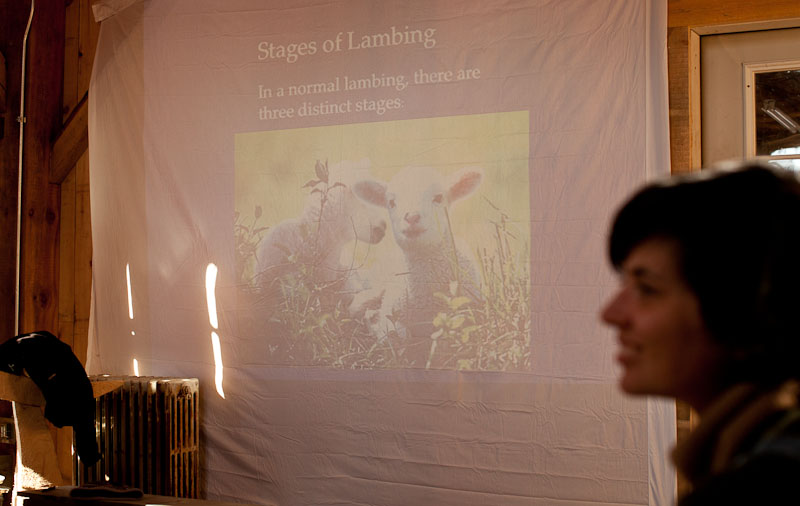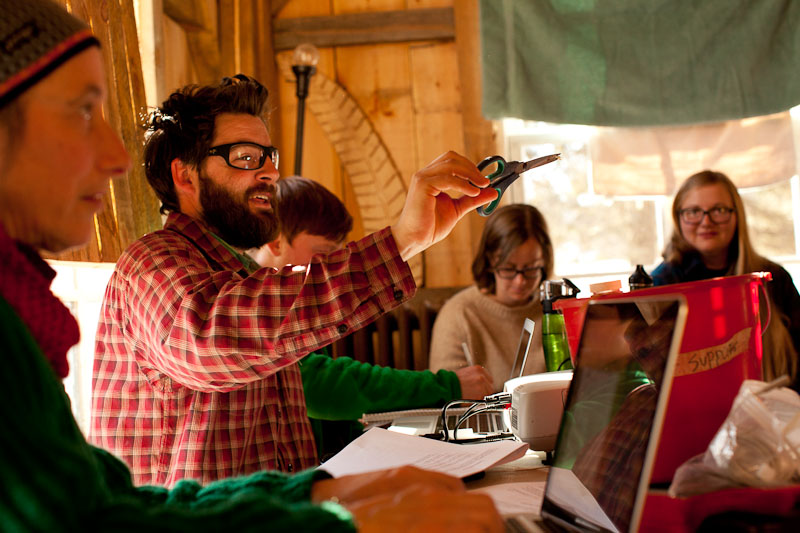Learning of Lambs and Labor
According to our midwife, Swisher is wrong side up for this stage in the pregnancy. That means every time he tap dances, his little head bumps straight into Dina’s stomach. It also means if he stays like that, he’s headed down the waterslide the wrong way – feet first.This, among other things, is making his parents a little nervous.But come May when Swisher is scheduled to make his appearance, I might just have some experience with what to do (if I can remain conscious during the birth). Eleven of our ewes at the farm have been bred and are expecting in April. Last Friday, all 15 of us crammed into the shop extension for a Power Point presentation complete with diagrams of reproductive anatomy of sheep. As Josh our livestock manager described every possible lambing disaster, he tried to keep things calm by looping a Bach piano sonata through the tinny speakers of his laptop.In an ideal birth, we learned, lambs come out doing their best Superman impression: two hooves followed immediately by a muzzle. When this is the case, you should be able to sit back, watch the miracle unfold, and in mere 1-3 hours, a wriggly little lamb is deposited in the straw.But in about 5% of cases, things go wrong.“Nothing terrible happens, right?” asked Bongi, as we sat through one particularly tense video of a sheep struggling to deliver a lamb.Well . . . things occasionally go wrong. Head back. Two legs back. Four front hooves at the same time (in the case of twins). Elbows locked out. All of these presentations signal a problem and it will be our job is to intervene to save the life of ewe and lamb.
Eleven of our ewes at the farm have been bred and are expecting in April. Last Friday, all 15 of us crammed into the shop extension for a Power Point presentation complete with diagrams of reproductive anatomy of sheep. As Josh our livestock manager described every possible lambing disaster, he tried to keep things calm by looping a Bach piano sonata through the tinny speakers of his laptop.In an ideal birth, we learned, lambs come out doing their best Superman impression: two hooves followed immediately by a muzzle. When this is the case, you should be able to sit back, watch the miracle unfold, and in mere 1-3 hours, a wriggly little lamb is deposited in the straw.But in about 5% of cases, things go wrong.“Nothing terrible happens, right?” asked Bongi, as we sat through one particularly tense video of a sheep struggling to deliver a lamb.Well . . . things occasionally go wrong. Head back. Two legs back. Four front hooves at the same time (in the case of twins). Elbows locked out. All of these presentations signal a problem and it will be our job is to intervene to save the life of ewe and lamb. The fix for each is generally the same: insert a hand into birth canal, align slippery lamb parts into proper Superman position by pushing the lamb back inside if necessary, then coax it out without breaking its teeth or tearing poor mom.During this part of class, my mind wandered our own version of these same events. I know that if Swisher doesn’t behave we have options that are a bit more, well, sophisticated than those we’re learning for the sheep. But we’re still doing everything we can thing of to try and turn our little guy around: placing bags of frozen peas where we think his head is, dangling Dina upside down on an inverted ironing board (seriously) and singing silly songs, Pied Piper-like, straight into her belly. This usually ends with both of us in hysterics.But back to the sheep: It turns out that the growing lambs can kill their mother if they grow so large as to crowd out her internal organs, and specifically, her ability to eat. This is called ‘toxemia,’ and can ironically be caused by over-abundant nutrition in early pregnancy, which can encourage excessive growth of the lambs. Here at Maggie’s farm, we address this by carefully rationing the ewes’ food for the first few months of pregnancy to promote sensibly sized offspring, and thus easier births. I told all of this to Dina, who was not a bit surprised. She’s had trouble eating much of anything recently without pain as Swisher gradually takes over the space that formerly housed her stomach. After losing weight at her last weigh-in and some finger wagging from our midwife, Dina’s on some magic pills (thank you, Zantac) that should ward off our version of toxemia.Lambing rotations start April 1st. Each shift is 24 hours, during which we have to check on the sheep every two hours around the clock while still completing all of our other farm-y tasks: feeding and watering, chopping and stoking, pruning and prepping, oiling and wrenching and hammering, sleeping and eating. Well, not really sleeping.After signing up for my shifts, I thought ahead to what will likely be some very long days and nights and started to feel sorry for myself. But then I remembered: this is what I’m signing up for. A farm. A baby. A farm and all of its babies.Now, how is it that counting sheep is supposed to put you to bed?!
The fix for each is generally the same: insert a hand into birth canal, align slippery lamb parts into proper Superman position by pushing the lamb back inside if necessary, then coax it out without breaking its teeth or tearing poor mom.During this part of class, my mind wandered our own version of these same events. I know that if Swisher doesn’t behave we have options that are a bit more, well, sophisticated than those we’re learning for the sheep. But we’re still doing everything we can thing of to try and turn our little guy around: placing bags of frozen peas where we think his head is, dangling Dina upside down on an inverted ironing board (seriously) and singing silly songs, Pied Piper-like, straight into her belly. This usually ends with both of us in hysterics.But back to the sheep: It turns out that the growing lambs can kill their mother if they grow so large as to crowd out her internal organs, and specifically, her ability to eat. This is called ‘toxemia,’ and can ironically be caused by over-abundant nutrition in early pregnancy, which can encourage excessive growth of the lambs. Here at Maggie’s farm, we address this by carefully rationing the ewes’ food for the first few months of pregnancy to promote sensibly sized offspring, and thus easier births. I told all of this to Dina, who was not a bit surprised. She’s had trouble eating much of anything recently without pain as Swisher gradually takes over the space that formerly housed her stomach. After losing weight at her last weigh-in and some finger wagging from our midwife, Dina’s on some magic pills (thank you, Zantac) that should ward off our version of toxemia.Lambing rotations start April 1st. Each shift is 24 hours, during which we have to check on the sheep every two hours around the clock while still completing all of our other farm-y tasks: feeding and watering, chopping and stoking, pruning and prepping, oiling and wrenching and hammering, sleeping and eating. Well, not really sleeping.After signing up for my shifts, I thought ahead to what will likely be some very long days and nights and started to feel sorry for myself. But then I remembered: this is what I’m signing up for. A farm. A baby. A farm and all of its babies.Now, how is it that counting sheep is supposed to put you to bed?!
* * * * *

